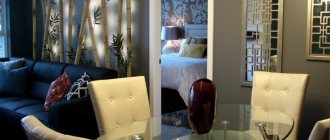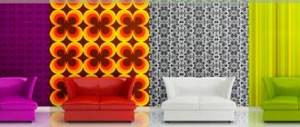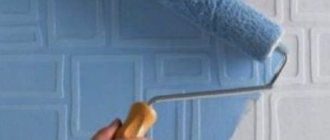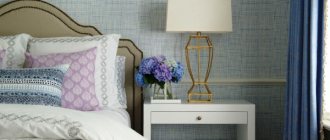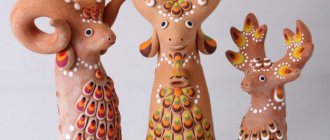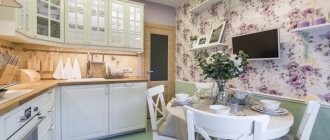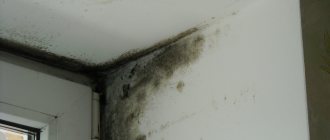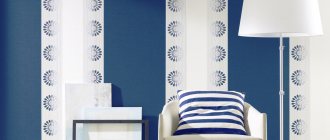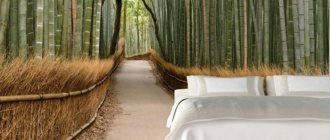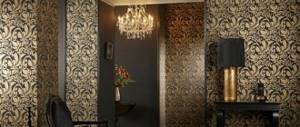If someone thinks that repairs are a simple thing, then they have never done it. Even cosmetic repairs without redevelopment and reconstruction cause apartment owners a lot of trouble. Even the seemingly simple procedure of wallpapering contains pitfalls.
Difficulties begin already at the beginning, with the choice of suitable material, color, pattern, texture and other little things on which the entire repair depends.
Most often, paper-based non-woven or vinyl wallpaper is chosen from a wide range of offers. The latter will be discussed. Vinyl wallpaper comes in two types:
- with non-woven lining;
- on paper basis.
In both cases, the wallpaper is durable, attractive in appearance and easy to clean. However, there are some things that differentiate these two types from each other:
- the paper base is less resistant to abrasion than non-woven material;
- paper-based wallpaper stretches a little when applying glue;
- The process of covering walls with such wallpaper is a little more difficult.
But paper-based wallpaper is much cheaper than non-woven wallpaper, and therefore is widely used in all rooms. However, regardless of the backing material, vinyl wallpapers have one main disadvantage - they almost do not allow air to circulate. This can lead to the spread of fungus and mold along the walls, and therefore should not be used in children's bedrooms and rooms that have little or no ventilation.
Vinyl wallpaper on paper basis in the interior:
But from year to year this problem is becoming less and less common, as manufacturers are improving technology and have already begun to produce wallpaper options that contain pores to allow air to pass through. This can also be solved by the fact that vinyl coating requires wet cleaning, and therefore the accumulation of dirt and dust can be easily avoided.
Varieties
But wallpapers are divided not only according to the type of base. There are several more principles:
- Structure:
- smooth;
- relief (textured).
- Finish:
- profile;
- embossed.
Let's talk separately about each option.
Foamed Vinyl
You've probably seen wallpaper with a pronounced relief surface, a convex pattern - this is wallpaper made from foam vinyl using the embossing method. Such wallpaper is often used in hallways and bedrooms, for unusual interior designs, since you can create absolutely any surface - imitate plaster, for example. This wallpaper, being dense and textured, will perfectly hide unevenness and defects in the walls, and can also be used to decorate kitchens and bathrooms. Foamed vinyl also perfectly transfers decorative elements - this is beneficial for those who like to independently implement their creative ideas.
Wallpapering in the interior:
Flat Vinyl
Unlike the previous type, such wallpaper, as the name already implies, is a continuous flat vinyl surface. This is also done by embossing a design printed on the top word. Silk-screen printing also belongs to this type - wallpaper of this type is made using silk threads to imitate the texture of silk, smooth or embossed fabric. They are usually chosen for wallpapering bedrooms or living rooms due to their luxurious effect.
Polyplen
Such paper-based wallpapers are often purchased for gluing rooms with high humidity - kitchens, bathrooms and hallways. They are made by printing layers of fillers, pigments, polyvinyl chloride and stabilizers onto a paper base. They also withstand both wet and dry cleaning and do not deteriorate.
Hard Vinyl
Vinyl that has undergone heat treatment is stripped of all harmful substances and therefore becomes completely safe for health. Such wallpaper is universal, but is especially often used in kitchens and children's bedrooms. They are environmentally friendly, breathable and can also be used to imitate all kinds of textures.
Properties and characteristics
Wall paper wallpaper is a non-woven material with a pattern applied with a special paint. In their production, substances are used that do not allow the pattern to spread.
All components (often coloring pigments) are environmentally friendly. This ensures safe living for people in rooms where the walls are decorated with paper wallpaper.
The canvases are based on crushed wood, which at one stage turns into a suspension. During further processing, the wood pulp is bleached, cleaned and made more viscous. For greater strength, the canvas is laminated over the applied pattern.
Depending on the texture, paper webs are classified into smooth (the pattern is applied by printing) and embossed, having a voluminous texture, a coarse fiber structure or duplex embossing.
Paper wall panels with duplex embossing are considered one of the most durable, since they consist of several layers. Coarse fiber wallpaper also includes several layers with a middle layer of wood chips.
All subtypes of relief canvases are stronger and denser, which allows them to well reinforce the surface and mask minor defects.
Quality characteristics depend on the weight of the wallpaper, they can be:
- Light, weighing 110 g per 1 sq.m.
- Average weight - from 110 g to 140 g per 1 sq.m.
- Heavy, weight is more than 140 g per 1 sq.m.
Accordingly, the lighter the canvas, the lower its density and strength.
We recommend: The harm of wallpaper: the choice is huge, but are all coatings environmentally friendly?
Peculiarities
Pasting walls with paper-based vinyl wallpaper differs little from similar processes using, for example, non-woven wallpaper. However, some significant differences can be identified, and these nuances will help you avoid making mistakes, due to which the finishing work will have to be redone several times:
- if the walls in the room were poorly primed, plastered and sanded, and there were unevenness or other defects left on them, then you definitely should not choose silk-screen printing: this type of wallpaper will even more clearly reveal bumps or cracks and ruin the interior;
- since, as mentioned earlier, the paper base is somewhat thinner than non-woven material, you should not overuse glue: this can cause the wallpaper to become deformed and stretch;
- You should also be careful when handling the wet fabric on which the adhesive is applied, as you can tear it;
- Due to its high density, such wallpaper is highly not recommended to be glued overlapping - only end-to-end, taking into account the pattern or design;
- You cannot ventilate the room while gluing, nor turn on the air conditioning - the room temperature should be about 25 degrees.
Types of wallpaper
To make the right choice, you should carefully understand what types of wallpaper are available for walls, what their technical characteristics and operational features are.
Below are all types of wallpaper with their nuances - pros and cons. Some of them require special conditions and careful care, others are more durable and unpretentious to use. After familiarizing yourself with what types of wallpaper there are for walls, you can decide which wallpaper to choose for a particular room.
Vinyl
These finishing materials are the most practical and wear-resistant. Structurally, they consist of two or more layers - they are created on a paper or non-woven basis:
- Interior. Designed for applying wallpaper glue.
- External. Performs a decorative function - drawings and tinting are applied to it. In some cases, the role of the inner and outer layers is played by one sheet of paper or non-woven backing.
- Protective film made of polyvinyl chloride.
Vinyl fabric
The presence of a protective film on the surface makes them resistant to moisture, detergents, ultraviolet radiation, and abrasion. This option is usually chosen when you need high-quality but inexpensive wallpaper for the wall.
Among the disadvantages of vinyl sheets is the tightness of the protective film. As a result, they interfere with normal gas exchange in the room and the removal of excess moisture and carbon dioxide.
Non-woven
Non-woven wallpaper is a material created on the basis of cellulose. Cellulose fibers are glued together using polymer adhesives. The main difference between non-woven fabric and paper is that its fibers are more tensile and resistant to various external influences.
There are two types of wallpaper on sale, made on a non-woven base. In the first case, it is single-layer wallpaper, on one side of which a decorative pattern is applied, and the other is intended for applying glue.
Two-layer non-woven wallpaper is a base made of cellulose fabric, onto the front side of which a protective film of polyvinyl chloride is glued. Such non-woven wallpapers are often classified as vinyl. Among the positive qualities of this material are:
- High strength.
- Breathability.
- Resistant to water.
- Possibility of painting with various paints and varnishes.
Textile
Wall decoration with textiles
Fabric wallpaper for walls can be made either entirely from textile fabric, or the woven component can be glued to paper or non-woven fabric.
The main advantage of this material is its high decorative qualities and a wide selection of colors. However, fabric wallpaper for walls has a number of disadvantages. First of all, it is low resistance to external aggressive influences - abrasion, sunlight, etc., therefore, these types of wallpaper are not recommended for covering children's rooms, hallways, and public reception areas. Also, when gluing, special care should be taken so that drops of glue do not fall on the fabric.
Velor
At their core, they are a two-layer structure made on the basis of paper wallpaper. Nylon fibers are glued onto the front side of the paper webs. In this case, the fibers are glued “upright”, creating the semblance of a short pile no more than 1 mm long.
The velor surface feels like velvet and shimmers in the light. Like textiles, velor fabrics should be glued with great care so as not to get dirty with wallpaper glue.
Their disadvantage is that the velor pile is easily picked out. In this regard, it is not advisable to clean wallpaper with a damp brush or sponge. Another disadvantage is that the pile attracts dust, so the walls get dirty quite quickly.
Paper
Paper wallpaper for walls is the very first type of such decoration, the history of which goes back centuries. Until recently, these types of wallpaper for walls were the only ones available for sale. But even today they top the popularity rating among wall finishing materials. This became possible due to the fact that a large assortment of wallpaper varieties of this type has appeared on the modern market.
The paper base is used for the manufacture of vinyl, textile and velor fabrics. In addition, there are many new types of wallpaper made purely from paper - with a variety of patterns, textured embossing and improved performance characteristics.
To understand well what modern paper wallpaper is, to understand which is better and why, you need to take a closer look at this group of finishing materials.
Preparation for gluing
Preparing walls for gluing is a very important stage, because the outcome of all work depends on it. Correct, consistent wall treatment is the key to high-quality repairs and an impeccable appearance of the room. There are several stages in preparing the surface for gluing:
- First of all, you need to dismantle the old coating - be sure to remove them, otherwise further gluing will be impossible.
- In the next steps, prime the surface and let it dry thoroughly.
- In case of pronounced defects, cracks, dents or bumps - putty, leveling the surface.
- After the plastered wall has completely dried, you can begin sanding: using special tools for grouting, sand the walls until they are smooth.
- Remove dust accumulated as a result of processing with a damp cloth, rags or sponge.
Pasting walls
Now you can start preparing the adhesive. First, you need to use measuring tools to make marks on the wall for orientation. This will help avoid crookedly pasted stripes.
Depending on whether you have a repeating pattern on the wallpaper or not, cut the roll into strips of equal width; if there is a pattern, then cut sequentially, and if not, you can cut the canvas into several strips at once.
Repair experts are divided in their opinions on which sequence is best to use when wallpapering. Some say that you need to start with the wall farthest from the window, and some say the opposite - that you need to glue from the window. Choose the method that is more convenient for you. The main thing to monitor is the room temperature. The optimal temperature will prevent the appearance of defects such as stains, bubbles and cracks on the newly glued coating. The wallpaper must dry for at least a day, otherwise the quality of work will decrease.
Here are some nuances you need to know:
- Keep the room temperature no higher than 25 degrees. The most optimal figure is 23 degrees.
- The glue should be of a uniform consistency, gel-like, without debris or lumps. Before use, let it reach the desired condition by waiting at least 10 minutes.
- Mark the canvas and cut it on a hard surface: on the floor or on a table.
- You need to apply the glue to the wall - it is not necessary to apply it to the wallpaper.
Now you know what they consist of and what subtleties are involved in gluing paper-based wallpaper. The following video will also help you learn how to glue them correctly:
Recommended Posts
3d wallpaper for the living room + photo
How to properly glue wallpaper on drywall with and without putty…
How to hang wide wallpaper
Beige wallpaper in the interior
Brick wallpaper in the hallway and corridor
Erismann wallpaper in the interior
Paper wallpapers for walls and their types
There are several types of paper wallpaper.
Types of paper wallpaper:
- Simplex is a type of thin wallpaper in one layer with a printed pattern; the top varnish coating creates a top layer that allows you to wash the wallpaper;
- Duplex - wallpaper with several layers with an embossed image, this type of wallpaper is durable, durable and easy to use, they can be easily and simply glued to walls;
- Photo wallpaper – paper wallpaper with a photo fragment applied to a large canvas;
- Structural wallpaper is a dense, durable, multi-layer material treated with a water-repellent composition; Such wallpaper will easily hide uneven walls, and it does not require special preliminary preparation of the surface for pasting.
Paper wallpaper can be used to cover walls in absolutely any room. Freshly hung wallpaper can give a room a clean and fresh look. Paper wallpaper is also good because paper has the ability to pass air through itself, and also transfer coolness from the walls to the room itself.
If the room is dirty, then it is advisable to give preference to washable types of wallpaper.
